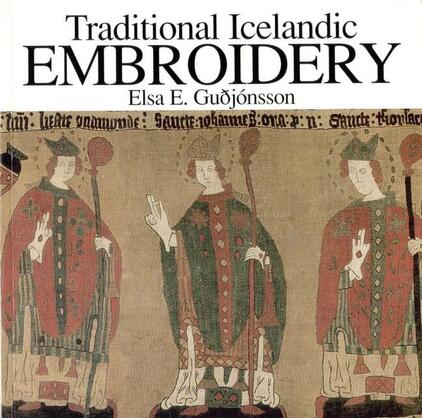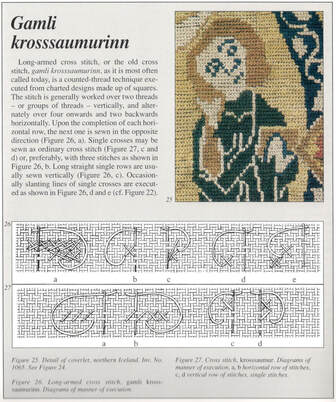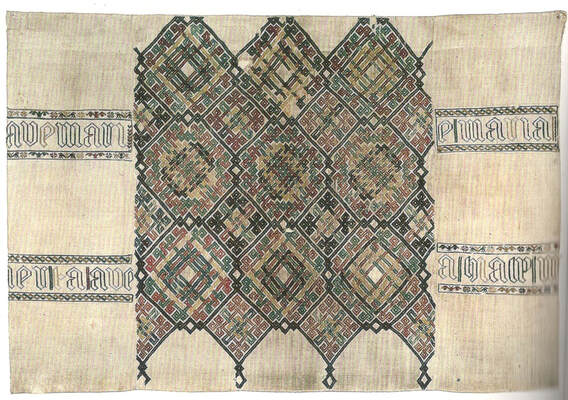|
Today I am going to review a lovely little book most of you would probably never have come across: Traditional Icelandic Embroidery by Elsa E. Gudjonsson written in 2006. In only 96 pages, Elsa gives an overview of Icelandic embroidery made during the past 500 years in English (!). Being a rather barren island where almost everything needs to be imported, the embroidery is of a special nature too. Whilst mainland Europe uses silks both for the threads and for the fabrics, Icelanders used wool on wool or linen. Both for ecclesiastical embroidery and for embroidery on folk dress and household items. The use of metal threads is rare. The book consists of two parts: History & Techniques and 23 pages of original patterns. The later have all been transcribed as cross-stitch patterns with a key for DMC stranded cotton. The book describes several techniques which are characteristic of Icelandic embroidery: Refilsaumur (laid and couched work), Glitsaumur & Skakkaglit (straight darning and pattern darning), Gamli krosssaumurinn (long-armed cross-stitch), Augnsaumur (eyelets), Pellsaumur (Florentine stitch or bargello), Sprang (darned net and drawn thread work) and Blomstursaumur Skattering (floral embroidery). Each technique is explained with stitch diagrams and pictures of historical pieces. I was especially surprised to find whole embroideries worked in long-armed cross-stitch after AD 1550. They remind me of the much earlier embroidered vestments now in St. Paul im Lavanttal, Austria. Interestingly, the name "Gamli krosssaumurinn" means old cross-stitch. Krosssaumur is the modern Icelandic name for cross-stitch embroidery. As for Continental Europe, modern cross-stitch does not feature in medieval embroidery. Unfortunately, very little is known about Icelandic embroidery in the Middle Ages due to a lack of surviving pieces and an absence in the written sources. Especially the latter is remarkable as there are plenty of sources describing textiles. However, the few sources that exist indicate that women were the embroiderers. There are no instances of men being named as embroiderers. Especially upper-class women and nuns were involved in the production of high-end embroideries for the church. This tradition continued after Iceland became Lutheran in AD 1550. One particularly saucy embroidery story involves Helga Sigurdardottir. She was the wife (yup, they did things a little differently in Iceland) of the last Catholic bishop of the see of Holar, Jon Arason. In AD 1526 they drew up a contract in which was stipulated that Helga would make embroideries for the church of Holar as long as she was able. She became a set income per year for her service. Helga's work must have been outstanding as she is named in a poem of AD 1594 as one of the most skilful needlework women of her day. Helga probably trained up her grand-daughter Pora Tumasdottir who became a famous church needlework woman herself. And what happened to bishop Jon? He was killed by the troops of the Danish king in AD 1550 when he revolted and refused to accept the reformation of his church. Where to find this book? I bought my copy directly from the National Museum of Iceland for about €23 + shipping. They also have a second book that might interest you: a facsimile of Icelandic pattern books from the 17th-, 18th- and 19th-centuries. However, that one is quite pricey at €180. Pictures of several pages of these original pattern books are included in the embroidery book by Elsa. I know that these books can probably be had from Amazon and the like. But please consider ordering from the National Museum directly. Museums are hit hard by the pandemic due to closure or greatly reduced numbers of visitors due to the absence of tourists. The Museum shipped my book immediately and it was here within two weeks. The ordering process is easy with a credit card and completely in English.
P.S. Virginia Sullivan won last week's giveaway and has been contacted. The cross-stitch charts are on their way to her. A thank you to all who participated!
18 Comments
Štikarca
1/3/2021 21:12:37
Love how you present the book. Your enthusiasm for embroidery pours from the words.
Reply
1/3/2021 21:25:04
You are very welcome! I was suprised how much information there was in this compact book. And once the library in Munich opens again (we have a lockdown), I will use the literature list in the back to find out more information on the medieval embroideries from Iceland!
Reply
Alicia
1/3/2021 22:04:50
Another reason NOT to buy this book from Amazon - it is $120.00 in paperback! I checked the museum website today and the book was sold out in English, but I am sure it will be back in stock in future. Yes, get it from the museum!
Reply
2/3/2021 08:22:49
Prices are all of a sudden sky rocketing on all second-hand book websites. Never underestimate the power of a blog article :).
Reply
Alicia
1/3/2021 22:21:47
Another thing I forgot to note in my last comment - there is a difference in conversion values between the Icelandic and the Swedish kroner. When computing your costs, make sure you have the correct currency as the Swedish kroner is way too expensive in computing the cost of this book for US customers (I did not know not all kroner is the same!).
Reply
2/3/2021 08:23:52
But isn't that the same for Canadian dollar and US dollar?
Reply
Claire
2/3/2021 07:19:19
Thank you Jessica. A friend of mine got me this book last year and I did try to write an article about it on my website but the museum refused to provide free photos so I had to give up. But yes, the book is really interesting and while I was doing my research about Icelandic embroidery, I "met" with local artists and wrote one portrait of a lady who works with Icelandic rocks and threads. I was in contact with other artists too, but they were too busy to continue our project... I'm sad about it because this island really does have a great history with embroidery up to now!
Reply
2/3/2021 08:30:22
That's a real shame Claire! I have noticed too that it is often a struggle to convince museums that my blog article will bring them benefits.
Reply
2/3/2021 16:15:31
True! That's the set of vestments from Holar cathedral.
Reply
Jana
3/3/2021 11:02:43
Thank you for your blog post. I love Icelandic historical textiles. Especially this embroidery on the last picture, this will be my next embroidery project.
Reply
3/3/2021 12:04:55
You are welcome, Jana! Would love to see your rendition of that particular embroidery one day.
Reply
Nancy B
3/3/2021 11:21:55
Thanks for the "heads up" regarding Elsa Gudjonsson's work. This book strongly reminds me of Nancy Spies in her "Here be Wyverns" and "Here Be Drolleries", which are both books of patterns charted from medieval sources. I often refer to them for ideas. Nancy Spies meticulously gives sources for her designs, which often means one can look at the original online, but I presume the Gudjonsson book is more academic in its approach. I'll look forward to acquiring this book when it becomes available in English again (which I hope it does).
Reply
3/3/2021 12:09:23
Glad you found it helpful, Nancy! Yes, The Elsa Gudjonsson book is a bit academic and in essence a summary of years and years of research.
Reply
Jeremy
14/7/2022 01:54:07
I can't find the english version on the museum's website. Hopefully, it hasn't gone out of print.
Reply
Your comment will be posted after it is approved.
Leave a Reply. |
Want to keep up with my embroidery adventures? Sign up for my weekly Newsletter to get notified of new blogs, courses and workshops!
Liked my blog? Please consider making a donation or becoming a Patron so that I can keep up the good work and my blog ad-free!
Categories
All
Archives
July 2024
|
Contact: info(at)jessicagrimm.com
Copyright Dr Jessica M. Grimm - Mandlweg 3, 82488 Ettal, Deutschland - +49(0)8822 2782219 (Monday, Tuesday, Friday & Saturday 9.00-17.00 CET)
Impressum - Legal Notice - Datenschutzerklärung - Privacy Policy - Webshop ABG - Widerrufsrecht - Disclaimer
Copyright Dr Jessica M. Grimm - Mandlweg 3, 82488 Ettal, Deutschland - +49(0)8822 2782219 (Monday, Tuesday, Friday & Saturday 9.00-17.00 CET)
Impressum - Legal Notice - Datenschutzerklärung - Privacy Policy - Webshop ABG - Widerrufsrecht - Disclaimer









 RSS Feed
RSS Feed